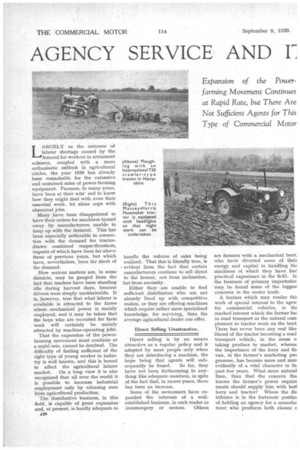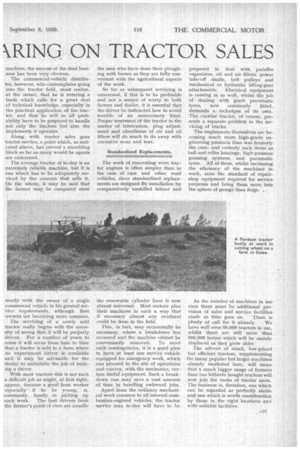AGENCY SERVICE AND r \RING ON TRACTOR SALES
Page 28

Page 29

If you've noticed an error in this article please click here to report it so we can fix it.
LARGELY as the outcome of labour shortage caused by the demand for workers in armament schemes, coupled with a more enthusiastic outlook in agricultural circles, the year 1939 has already been remarkable for the extensive and sustained sales of power-farming equipment. Farmers, in many areas, have been at their wits' end to know how they might deal with even their essential work, let alone cope with abnormal jobs.
Many have been 'disappointed to have their orders for machines turned away by manufacturers unable to keep up with the demand. This has been especially noticeable in connection with the demand for tractordrawn combined reaper-Threshers, imports of which have been far above those of previous years, but which have, nevertheless, been far short of the demand.
How serious matters are, in some districts, may be gauged from the fact that tractors have been standing idle during harvest days, because drivers were simply unobtainable. It is, however, true that what labour is available is attracted to the farms where mechanical power is mainly employed, and it may be taken that the boys who are recruited for farm work will certainly be mainly attracted by machine-operating jobs.
That the expansion of the powerfarming movement must continue at a rapid rate, cannot be doubted. The difficulty of finding sufficient of the right type of young worker in industry is well known, and this is bound to affect the agricultural labour market. On a long view it is also recognized that all over the world it is possible to increase industrial employment only by releasing men from agricultural production.
The distributive business, in this field, is capable of great expansion and, at present. is hardly adequate to handle the volume of sales being realized. That this is literally true, is evident from the fact that certain manufacturers continue to sell direct to the farmer, not from inclination, but from necessity.
Either they are unable to find sufficient distributors who are not already lined up with competitive makes, or they are offering machines which require rather more specialized knowledge, for servicing, than the average agricultural dealer can offer.
Direct Selling Unattractive.
Direct selling is by no means attractive as a regular policy and is adopted by most people only when they are introducing a machine, the hope being that agents will subsequently be found. So far, they have not been forthcoming in anything like adequate numbers, in spite of the fact that, in recent years, there has been an increase.
Some of the newcomers have expanded the interests of a wellestablished business, in such trades as ironmongery or motors. Others are farmers with a mechanical bent, who have diverted some of their energy and capital to handling the machines of which they have had practical experience in the field. Ir the business of primary importatior may be found some of the bigges1 concerns in the motor trade.
A feature which may render this work of special interest to the agen, for commercial, vehicles, is the marked interest which the farmer ha.: in road transport as the natural corn plement to tractor work on the land There has never been any real like lihood of the tractor becoming a road transport vehicle, in the sense o taking produce to market, wherea: the importance of the lorry and till van, in the farmer's marketing pro gramme, has become more and mon evidently of a vital character in thi past few years. What more natural then, than that the concern tha knows the farmer's power require ments should supply hirn with botl lorry and tractor? Where the dis tributor is in the fortunate positioi of.holding an agency for a manufac turer who produces both classes o machine, the success of the dual business has been very obvious.
The commercial-vehicle distributor, however, who contemplates going into the tractor field, must realize, at the outset, that he is entering a trade which calls for a great deal of technical knowledge, especially in the practical application of the tractor, and that he will in all probability have to be prepared to handle not only the tractors but also the implements it operates.
Along with tractor sales goes tractor service, a point which, as indicated above, has proved a stumbling block so far as many would-be agents are concerned.
The average tractor of to-day is an extremely reliable machine, but it is one which has to be adequately serviced by the concern that sells it. On the whole, it may be said that the farmer may be compared most nearly with the owner of a single commercial vehicle in his general service requirements, although fleet owners are becoming more common.
The servicing of a newly sold tractor really begins with the necessity of seeing that it will be prop. erly driven. For a number of years. to come it will occur from time to time that a tractor is sold to a farrn where no experienced driver is available and it may be advisable for the dealer to undertake the job of training a driver.
With most tractors this is not such a difficult job as might, at first sight, appear, because a good farm worker especially ' if he be young, is, commonly, handy in picking up such work. The best drivers from the farmer's point of view are usually the men who have done their ploughing with horses as they are fully conversant with the agricultural aspects of the work.
So far as subsequent servicing is concerned, if this is to be profitable and not a source of worry to both fanner and dealer, it is essential that the driver be instructed how to avoid trouble of an unnecessary kind. Proper treatment of the tractor in the matter of lubrication, plug adjustment and cleanliness of air and oil filters will do much to do away with excessive wear and tear.
Standardized Replacements.
The work of renovating worn tractor engines is often simpler than in the case of cars and other road vehicles, since standardized replacements are designed for installation by comparatively unskilled labour and the renewable cylinder liner is now almost universal. Most makers plan their machines in such a way that if necessary almost any overhaul could be done in the field.
This, in fact, may occasionally be necessary, where a breakdown has occurred and the machine cannot be conveniently removed. To meet such contingencies, it is a good plan to have at least one service vehicle equipped for emergency work, which can proceed to the site of operations and convey, with the mechanics, certain iTseful equipment. Such a breakdown van may save a vast amount of time in handling awkward jobs.
Apart from the ordinary mechanical work common to all internal-combustion-engined vehicles, the tractor service mAn to-day will have to be prepared to deal with paraffin vaporizers, oil and air filters, power take-off shafts, belt pulleys and mechanical or hydraulic lifting-gear attachments. Electrical equipment is coming in as well, whilst the job of dealing with giant pneumatic tyres, now commonly fitted, demands a technique of its own. The crawler tractor, of course, presents a separate problem in the servicing of tracks.
The implements themselves are becoming much more high-grade engineering products than was formerly the case, and embody such items as ball and roller bearings, high-pressure greasing systems, and pneumatic tyres. All of these, whilst increasing the efficiency of the machines in work, raise the standard of repairshop equipment required for service purposes and bring them more into the sphere of garage than forge. .
As the number of machines in use rises there must be additional provision of sales and service facilities made as time goes on. There is plenty of call for it already. We have well over 50.000 tractors in use, whilst there are still more than 500,000 horses which will be mainly displaced as they grow older.
The advent of small, low-priced but efficient tractors, supplementing the many popular but larger machines already marketed here, will mean that a much bigger range of farmers than has hitherto bought tractors will , now join the ranks of tractor users. The business is, therefore, one which can be regarded as perfectly stable and one which is worth consideration by those in the right locations and with suitable facilities.




































































